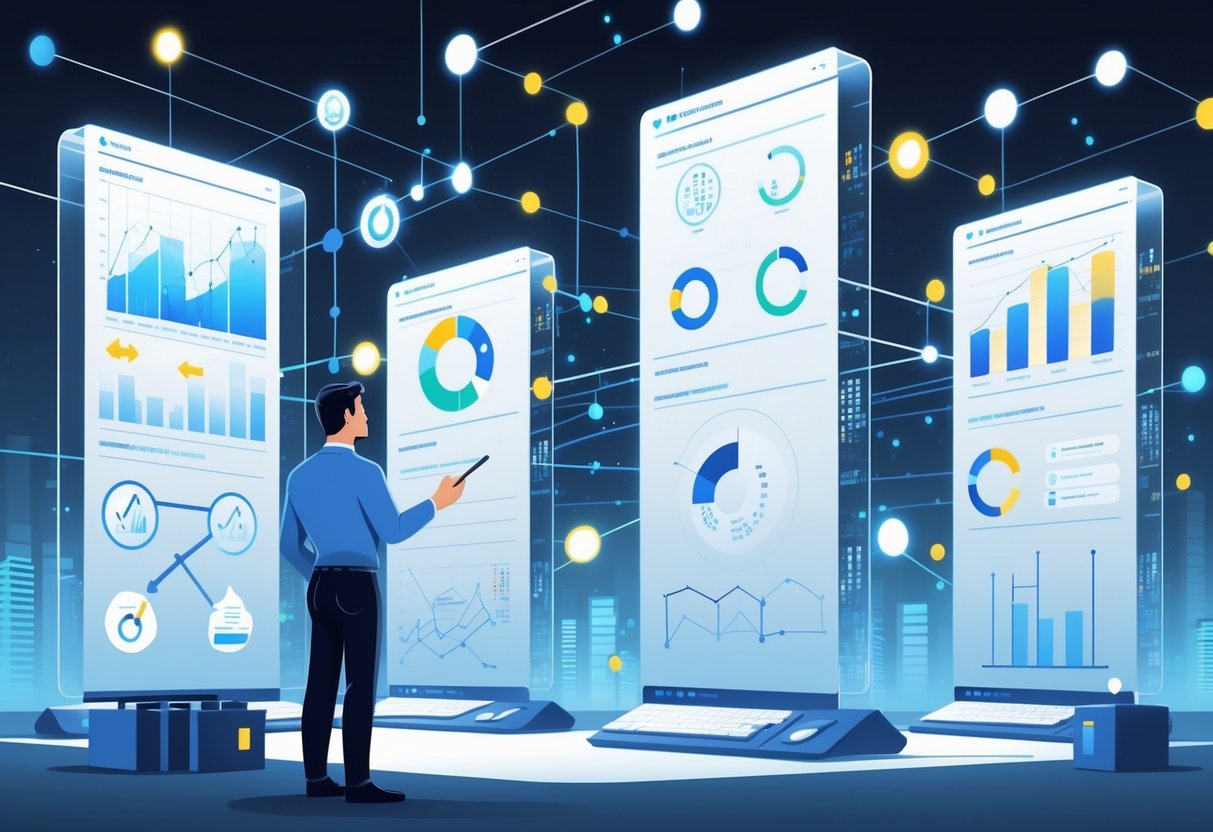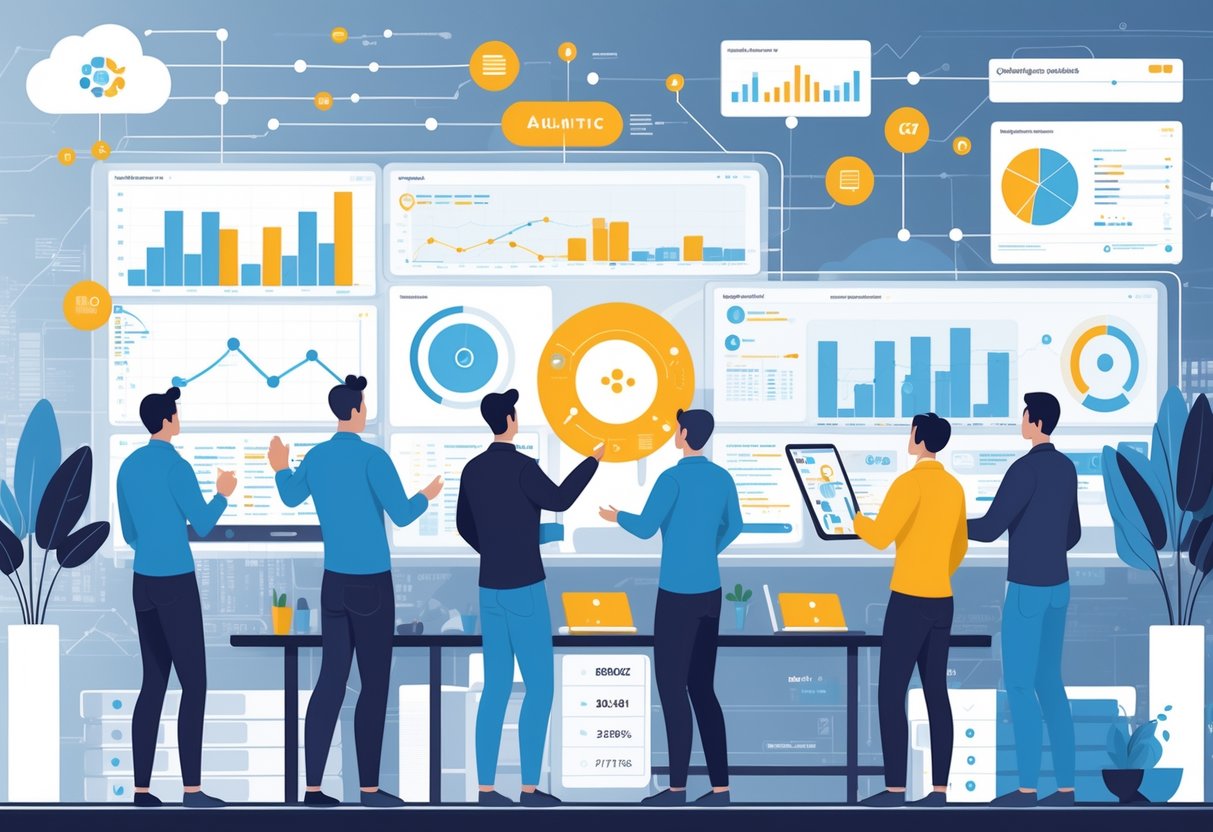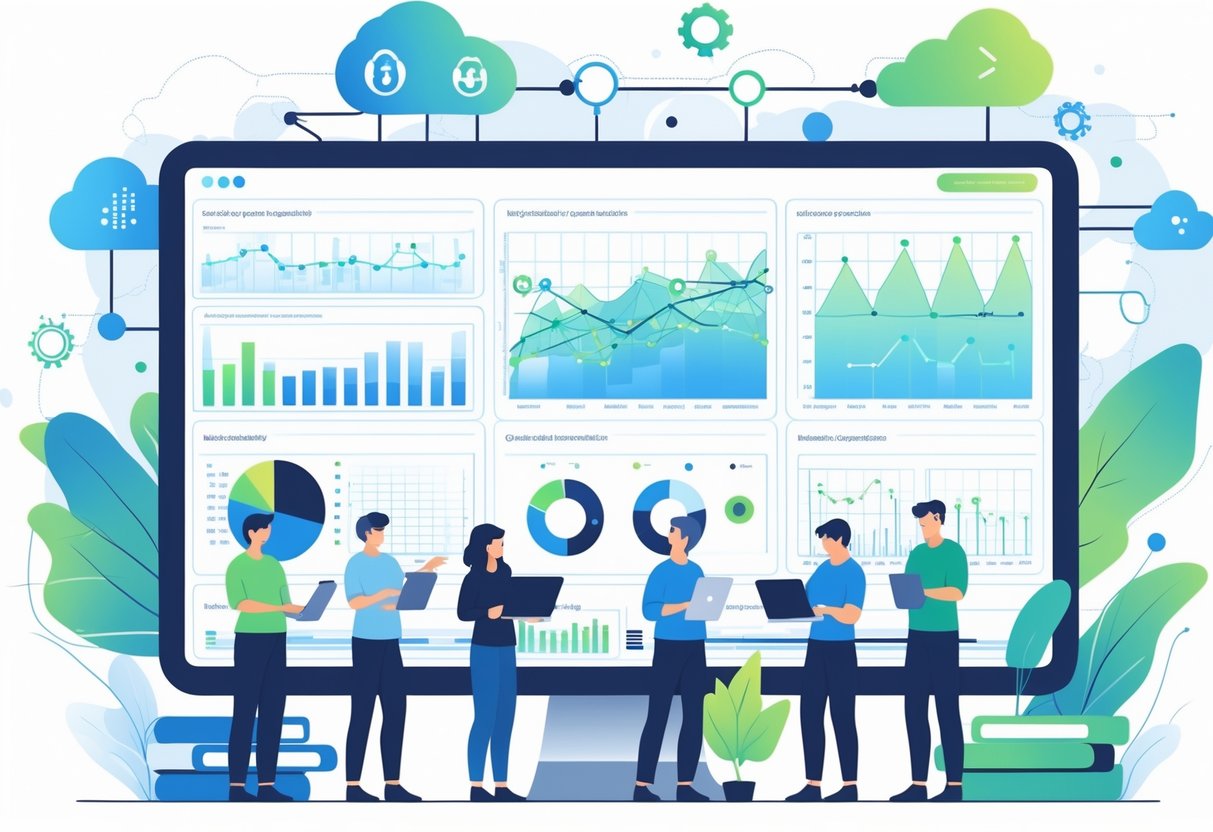Analytics engineers work at the center of modern data teams, building the models and transformations that turn raw data into business insights. Yet many struggle with data quality issues, pipeline failures, and unclear system performance that undermine their work. Data observability provides analytics engineers with complete visibility into data health, quality, and pipeline performance, enabling them to catch issues before they impact business decisions.

Data observability helps analytics engineers monitor, understand, and troubleshoot their data systems through five key pillars: freshness, distribution, volume, schema, and lineage. This approach goes beyond basic monitoring to provide deep insights into how data moves through pipelines and where problems occur. Bad data costs organizations an average of $12.9 million per year, making observability essential for maintaining reliable analytics.
This guide explores how analytics engineers can use data observability to improve their workflows, prevent costly data issues, and build more reliable systems. We’ll cover the core concepts, essential tools, implementation strategies, and future trends that every analytics engineer should understand.
Key Takeaways
- Data observability gives analytics engineers complete visibility into data quality and pipeline health through five core pillars
- Analytics engineers benefit from faster issue detection, improved data reliability, and better collaboration with data teams
- Modern observability tools automate monitoring processes and use machine learning to identify potential problems before they impact business decisions
What Is Data Observability?

Data observability represents a comprehensive approach to understanding data health across modern data stacks. It combines automated monitoring with deep insights into data quality, lineage, and system performance to prevent issues before they impact business operations.
Defining Data Observability
Data observability provides full visibility into data health across systems and pipelines. It enables teams to detect when data is wrong, identify what broke, and determine how to fix it quickly.
The practice encompasses five core pillars that work together:
- Freshness: How up-to-date data tables are and their update frequency
- Quality: Data accuracy, including null percentages and value ranges
- Volume: Completeness of data tables and unexpected changes in row counts
- Schema: Organizational changes that might indicate broken data flows
- Lineage: Upstream sources and downstream impacts when issues occur
Unlike traditional approaches, data observability monitors the entire data ecosystem rather than isolated components. This holistic view helps teams understand complex dependencies within their data stack.
The Evolution from Software Observability
Data observability builds on concepts from DevOps and software observability. Software teams have long used monitoring tools to track application performance and system health.
The data world adopted these principles to address growing complexity in modern data architectures. As organizations moved from simple pipelines to distributed systems, traditional data monitoring became insufficient.
Data observability changes the paradigm from focusing solely on data quality to examining entire pipelines. This shift makes data reliability a shared responsibility across engineering and analytics teams.
The evolution reflects the need for proactive rather than reactive approaches. Teams can now identify potential issues before they cascade through downstream systems.
Key Principles of Data Observability
Automation drives effective data observability. Manual testing cannot scale with modern data volumes and complexity. Automated anomaly detection and monitoring eliminate the need for constant human oversight.
Context matters more than metrics alone. Data observability focuses on troubleshooting and root cause analysis rather than just tracking issues. Understanding why problems occur prevents future incidents.
End-to-end visibility connects the dots. Teams need to see how data flows through their entire stack. This includes source systems, transformation processes, and final consumption points.
Real-time insights enable faster resolution. Traditional batch monitoring creates delays between when issues occur and when teams discover them. Modern data observability provides immediate alerts and diagnostic information.
The Role of Analytics Engineers in Data Observability

Analytics engineers serve as the bridge between raw data infrastructure and business intelligence, making them critical players in implementing data observability practices. They ensure data models remain reliable while collaborating with various team members to maintain data quality that drives accurate business insights.
Responsibilities in Modern Data Teams
Analytics engineers hold unique responsibilities that make them essential for data observability implementation. They build and maintain data models that transform raw data into business-ready analytics.
Data Model Monitoring
Analytics engineers monitor the health of their data transformations. They track metrics like model run times, row counts, and data freshness to catch issues early.
Quality Assurance
They implement data quality checks within their transformation code. These checks validate assumptions about data distribution, null values, and business logic constraints.
Documentation and Lineage
Analytics engineers document their data models and maintain clear lineage tracking. This helps teams understand how business metrics connect to source data.
Alerting Systems
They set up alerts for failed transformations or unexpected data patterns. These alerts prevent bad data from reaching business users and dashboards.
Collaboration Across Data Functions
Analytics engineers work closely with multiple roles across data teams to ensure comprehensive data observability coverage.
With Data Engineers
They collaborate on upstream data pipeline monitoring. Analytics engineers provide feedback about data quality issues that affect their models and transformations.
With Data Analysts
They partner with data analysts to understand business logic requirements. This collaboration ensures data models meet analytical needs while maintaining observability standards.
With Data Scientists
Analytics engineers support data scientists by providing clean, monitored data sets for machine learning projects. They ensure feature engineering pipelines include proper observability controls.
Cross-Team Communication
They translate technical data issues into business terms. This communication helps stakeholders understand the impact of data quality problems on their work.
Impact on Business Decisions
Analytics engineers directly influence the reliability of business decisions through their observability practices. Their work ensures decision-makers access accurate, timely data.
Preventing Bad Decisions
They catch data anomalies before they reach executive dashboards. This prevents leaders from making choices based on incorrect metrics or outdated information.
Building Trust in Analytics
Analytics engineers create confidence in data systems by implementing transparent monitoring. Business users trust metrics more when they understand the quality controls behind them.
Reducing Time to Resolution
They design observability systems that quickly identify root causes of data issues. This rapid response minimizes the time business teams work with unreliable data.
Supporting Data-Driven Culture
Analytics engineers enable data-driven organizations by ensuring consistent data quality. Their observability work makes it safe for teams to rely on data for critical choices.
Why Analytics Engineers Should Care About Data Observability

Poor data quality creates cascading problems that directly impact analytics engineers’ ability to deliver reliable insights. Data observability helps maintain data quality and reduces the time spent troubleshooting broken pipelines while building stakeholder confidence in analytical outputs.
The Cost of Ignoring Data Quality
Analytics engineers face significant productivity losses when data quality issues go undetected. Without proper monitoring, they spend hours investigating anomalies that could have been caught automatically.
Time-to-resolution (TTR) increases dramatically when problems surface in downstream reports rather than at the source. An analytics engineer might discover a data quality issue only after stakeholders report incorrect dashboard metrics.
The financial impact compounds quickly. Marketing teams making decisions with stale customer data waste budget on ineffective campaigns. Sales teams using incorrect pipeline data miss revenue targets.
| Problem Type | Detection Time | Resolution Effort |
|---|---|---|
| Schema changes | Hours to days | 2-4 hours |
| Missing data | Days to weeks | 4-8 hours |
| Stale data | Weeks | 1-3 hours |
Analytics engineers also lose credibility when delivering unreliable results. Stakeholders begin questioning all analytics outputs, not just the problematic ones.
Enabling Trustworthy Analytics Outcomes
Data observability builds trust in data by providing transparency into data health and processing status. Analytics engineers can confidently share insights knowing their underlying data meets quality standards.
Automated monitoring prevents silent failures that corrupt analytical models. Schema validation catches structural changes before they break downstream transformations.
Real-time alerts notify analytics engineers when data freshness drops below acceptable thresholds. They can address issues proactively rather than reactively.
Lineage tracking shows exactly how data flows through each transformation step. When stakeholders question results, analytics engineers can quickly demonstrate data accuracy and processing logic.
Data profiling reveals distribution changes that might indicate collection problems. An analytics engineer notices when customer age data suddenly skews older, suggesting a data source issue.
This transparency enables faster decision-making across the organization. Stakeholders trust analytical outputs and act on insights without hesitation.
Reducing Downstream Data Issues
Data pipeline monitoring helps analytics engineers identify problems before they propagate to business-critical reports and dashboards. Early detection prevents data quality issues from affecting multiple downstream systems.
Volume monitoring catches missing data batches immediately. If daily transaction data drops by 50%, alerts trigger before nightly reporting jobs run with incomplete information.
Analytics engineers can set up automated quality checks at each pipeline stage. These checks validate data completeness, accuracy, and consistency throughout the transformation process.
Schema monitoring prevents breaking changes from disrupting analytical workflows. When source systems modify column names or data types, observability tools alert analytics engineers before transformations fail.
Root cause analysis capabilities help analytics engineers trace problems back to their origin quickly. Instead of checking multiple pipeline stages manually, they follow automated lineage maps to find the exact failure point.
This proactive approach reduces the number of data incidents that reach end users. Analytics engineers spend less time firefighting and more time building valuable analytical solutions.
Core Pillars and Metrics of Data Observability

Data observability relies on four key pillars: freshness, distribution, schema, and lineage. These pillars provide complete visibility into data health through specific metrics that track how data moves through systems.
Freshness and Timeliness
Data freshness measures how current data is within systems. Analytics engineers use freshness metrics to identify when data pipelines fail or slow down unexpectedly.
Key freshness metrics include:
- Time since last update
- Data arrival delays
- Processing lag times
- Batch completion rates
Most teams set freshness alerts based on business needs. Daily reports might allow 2-hour delays. Real-time dashboards need updates within minutes.
Freshness tracking helps teams catch upstream failures quickly. When source systems go down, freshness metrics show the impact immediately. This prevents bad decisions based on stale data.
Teams often use SLA-based freshness monitoring. They define acceptable delay windows for each data pipeline. Alerts fire when data exceeds these limits.
Distribution and Volume
Distribution metrics track data patterns and volumes over time. These data quality metrics help identify unusual changes that might signal problems.
Volume metrics monitor:
- Row counts per table
- File sizes in storage
- Record processing rates
- Data growth trends
Distribution analysis looks at value ranges and patterns. Sudden changes in averages, missing values, or data ranges often indicate upstream issues.
Teams typically set volume alerts using statistical methods. They track normal ranges for each dataset. Alerts fire when volumes fall outside expected boundaries.
Distribution monitoring catches data quality problems early. Missing files, incomplete loads, and duplicate records all show up in volume metrics. This prevents corrupted data from reaching business users.
Schema and Data Structure
Schema monitoring tracks changes to data structure and format. Analytics engineers need alerts when columns change, disappear, or contain unexpected data types.
Schema metrics include:
- Column additions or deletions
- Data type changes
- Null value increases
- Format violations
Schema drift breaks downstream data pipelines without warning. When source systems add new fields or change formats, dependent processes fail. Schema monitoring prevents these surprises.
Most teams use automated schema validation. They compare current structures against expected formats. Any differences trigger immediate alerts to data teams.
Schema monitoring also tracks data contracts between systems. Teams define expected formats and validation rules. Automated checks ensure all data meets these standards before processing.
Data Lineage
Data lineage tracks how data flows through systems from source to destination. This visibility helps teams understand dependencies and trace problems to their root causes.
Lineage mapping shows:
- Data source origins
- Transformation steps
- System dependencies
- Impact analysis paths
When problems occur, lineage helps teams find the source quickly. Instead of checking every system, they follow the data path backward to identify failures.
Lineage also helps with impact analysis. Teams can see which downstream systems depend on each data source. This prevents changes from breaking dependent processes unexpectedly.
Most data systems now provide automated lineage tracking. They record how data moves between tables, files, and applications. This creates complete maps of data pipelines without manual documentation.
Key Benefits for Analytics Engineers

Data observability delivers significant advantages that directly impact analytics engineers’ daily work and project success. These benefits focus on faster issue resolution, enhanced data reliability, and stronger governance frameworks that support better decision-making across organizations.
Accelerating Time to Detect and Resolve Issues
Analytics engineers face constant pressure to identify and fix data problems quickly. Data observability reduces Time To Detect (TTD) and Time To Resolve (TTR) by providing real-time visibility into data pipeline health.
Traditional troubleshooting requires engineers to manually check multiple systems. They examine data connections, verify data quality, and analyze application code to find root causes. This process often takes hours or days.
Observability tools alert engineers immediately when issues occur. They provide detailed context about what went wrong and where the problem started. This eliminates guesswork and reduces investigation time.
Key improvements include:
- Automated alerts for data anomalies
- Clear visibility into pipeline dependencies
- Faster root cause identification
- Reduced manual monitoring tasks
Engineers can spend more time building new analytics solutions instead of fixing broken ones. Business users also benefit from more reliable data delivery and fewer disruptions to their workflows.
Improving Data Reliability for Analytics
Data observability ensures higher reliability of data and greater confidence in analytics insights. Analytics engineers need to guarantee that their models and dashboards receive accurate, complete data.
Upstream data issues can break analytics models and produce incorrect insights. Missing tables, incomplete data loads, or schema changes often go undetected until business users report problems.
Observability monitors data quality continuously throughout the pipeline. It tracks metrics like completeness, accuracy, and freshness automatically. Engineers receive alerts before problems impact downstream analytics.
Quality monitoring covers:
- Data volume changes
- Schema drift detection
- Null value increases
- Statistical anomalies
This proactive approach prevents bad data from reaching production systems. Analytics engineers can maintain high-quality outputs that business teams trust for critical decisions.
Supporting Data Governance Initiatives
Analytics engineers play a crucial role in data governance programs. Data observability provides comprehensive monitoring and understanding of data behavior within systems supporting compliance and governance requirements.
Governance teams need clear documentation of data lineage, usage patterns, and quality metrics. Manual documentation often becomes outdated quickly and provides limited technical value for engineers.
Observability tools automatically capture data lineage, metadata, and usage statistics. They track how data flows through systems and which applications consume specific datasets. This creates living documentation that stays current.
Governance benefits include:
- Automated lineage tracking
- Usage pattern analysis
- Impact assessment capabilities
- Compliance reporting support
Engineers can demonstrate data quality controls and provide audit trails when needed. This automated approach reduces manual documentation work while improving governance visibility across the organization.
Common Data Quality Challenges Addressed by Observability

Data observability tackles critical problems that plague modern data systems by providing real-time monitoring and alerting capabilities. Analytics engineers can detect anomalies before they corrupt downstream analysis, prevent costly pipeline failures through early warning systems, and ensure data remains fresh and consistent across all systems.
Identifying Data Anomalies
Data observability tools comprehensively monitor data systems to catch unusual patterns that traditional quality checks might miss. These systems track statistical distributions, value ranges, and data patterns over time.
Automated anomaly detection works by establishing baseline metrics for normal data behavior. When values fall outside expected parameters, the system triggers immediate alerts.
Key anomaly types include:
- Sudden spikes or drops in record counts
- Unexpected null values in critical fields
- Schema changes that break downstream processes
- Duplicate records appearing in unique datasets
Analytics engineers benefit from machine learning-powered detection that learns from historical data patterns. This approach catches subtle anomalies that static rules would miss.
The system creates detailed logs of every anomaly detected. These logs help teams understand what went wrong and when the issue started.
Preventing Data Pipeline Failures
Data quality issues result from both machine and human errors and require proactive monitoring to prevent cascade failures. Observability platforms monitor each step of data pipelines in real-time.
Pipeline health monitoring tracks execution times, error rates, and resource usage across all data processing stages. Teams receive alerts when any metric exceeds normal thresholds.
Critical failure prevention includes:
- Memory usage alerts before systems crash
- Timeout warnings for long-running processes
- Dependency checks to verify upstream data availability
- Resource monitoring to prevent infrastructure overload
The platform maintains comprehensive logs of all pipeline activities. These logs show exactly where failures occur and what conditions led to the problem.
Automated rollback capabilities can revert problematic changes when issues are detected. This prevents bad data from propagating through the entire system.
Monitoring Data Freshness and Consistency
Implementing data observability transforms data management from reactive troubleshooting into proactive quality assurance by continuously monitoring data streams for freshness and consistency issues.
Freshness monitoring tracks when data was last updated across all systems. Analytics engineers set acceptable delay thresholds for each dataset.
The system checks:
- Last update timestamps for every table and dataset
- Processing delays between data ingestion and availability
- Missing batch loads that should have arrived on schedule
- Stale data warnings when information becomes outdated
Consistency validation ensures data matches across different systems and environments. The platform compares record counts, key metrics, and field values between related datasets.
Cross-system validation includes comparing production databases with data warehouse copies. Any discrepancies trigger immediate alerts with detailed logs showing exactly which records differ.
Teams can set custom consistency rules based on business requirements. The system automatically validates these rules and reports violations through centralized dashboards.
Essential Tools and Platforms for Data Observability

The data observability market includes specialized platforms like Monte Carlo and Datadog alongside comprehensive solutions that integrate directly with dbt workflows. These tools focus on automated monitoring, anomaly detection, and real-time alerting to maintain data pipeline health across the modern data stack.
Overview of Leading Data Observability Tools
Monte Carlo leads the data observability platform market as the first end-to-end solution built specifically for data teams. The platform uses machine learning algorithms to learn normal data patterns and detect anomalies before they impact downstream systems.
Specialized Data Platforms:
- Monte Carlo: End-to-end data reliability with ML-powered anomaly detection
- Acceldata: Multi-dimensional observability with Pulse, Torch, and Flow product suites
- Elementary: dbt-native platform designed specifically for analytics engineers
Datadog Observability Platform provides complete visibility into applications, infrastructure, and third-party services. It offers over 500 integrations to capture end-to-end traces, metrics, and logs in real-time.
Enterprise Observability Solutions:
- Datadog: Full-stack observability with 500+ integrations
- Dynatrace: AI-powered platform with automatic root-cause detection
- New Relic One: Unified telemetry platform with pay-per-use pricing
Cloud-native solutions like Amazon CloudWatch focus on AWS resources. These tools collect data across performance layers from frontend to infrastructure.
Comparing Data Observability Platforms
Data observability tools differ significantly in their approach to monitoring and integration capabilities. Monte Carlo claims SOC 2 compliance with security-first architecture, making it suitable for enterprise environments with strict compliance requirements.
Key Comparison Factors:
| Platform | Primary Focus | Integration Depth | Pricing Model |
|---|---|---|---|
| Monte Carlo | Data-specific observability | Deep data stack integration | Custom enterprise |
| Datadog | Full-stack monitoring | 500+ integrations | Usage-based |
| Elementary | dbt workflows | Native dbt integration | Open source + paid |
| Dynatrace | AIOps automation | 600+ technologies | Subscription |
Synq brings AI-native observability to data products rather than focusing solely on tables or pipelines. It integrates deeply with dbt, SQLMesh, and cloud data warehouses.
Traditional APM tools like Dynatrace and Datadog excel at infrastructure monitoring but require additional configuration for data-specific use cases. Specialized data observability platforms understand data lineage, schema changes, and data quality metrics natively.
Cost structures vary significantly between platforms. Some charge based on data volume processed, while others use subscription models or pay-per-query pricing.
Integrating with the Modern Data Stack
Modern data observability platforms integrate seamlessly with existing data stack components including data warehouses, transformation tools, and business intelligence platforms. Elementary provides dbt-native integration that works directly within existing dbt workflows without requiring separate infrastructure.
Common Integration Points:
- Data warehouses: Snowflake, BigQuery, Redshift, Databricks
- Transformation layers: dbt, SQLMesh, Airflow, Dagster
- BI tools: Looker, Tableau, Power BI, Mode
Most platforms offer no-code setup options that automatically discover data assets and relationships. Monte Carlo and Acceldata provide automatic data lineage mapping across the entire data stack.
API-first architectures enable custom integrations with proprietary tools. Datadog supports hundreds of languages and frameworks through pre-built instrumentation and custom APIs.
Cloud-native platforms like Amazon CloudWatch integrate automatically with AWS services but require additional work for multi-cloud environments. Cross-platform tools offer better flexibility for organizations using multiple cloud providers or hybrid architectures.
Real-time alerting systems connect to existing notification channels including Slack, PagerDuty, and email. This ensures data teams receive immediate alerts when issues occur without changing existing workflows.
Implementing Data Observability in Analytics Engineering

Successful implementation requires strategic monitoring practices, automated validation systems, and comprehensive lineage tracking. These components work together to create visibility into data health and pipeline performance.
Best Practices for Data Monitoring
Analytics engineers should focus monitoring efforts on critical data pipelines that directly impact business decisions. Start with high-impact pipelines to maximize return on investment before expanding coverage.
Key monitoring metrics include data freshness, volume changes, and schema evolution. Teams should establish baseline thresholds for normal operations. Alerts trigger when metrics exceed acceptable ranges.
Automated data quality monitoring reduces manual oversight and improves response times. Tools like Great Expectations enforce schema rules and validate data formats automatically.
Integration with existing workflows ensures monitoring becomes part of daily operations rather than an additional burden. Connect alerts to communication platforms like Slack or ticketing systems.
Teams should monitor these essential areas:
- Freshness: Data update frequency and delays
- Volume: Record counts and processing throughput
- Distribution: Statistical patterns and outliers
- Schema: Structure changes and field modifications
Continuous Data Validation
Continuous data validation is essential for maintaining data quality throughout the pipeline lifecycle. This proactive approach allows for continuous monitoring of anomalies, inconsistencies, and errors.
Validation rules should align with business requirements and data contracts. Define acceptable ranges for numerical fields, required formats for text data, and relationship constraints between tables.
Machine learning algorithms detect unusual patterns that rule-based systems might miss. Leading platforms use machine learning to identify outliers or unexpected changes in data distributions and processing times.
Real-time validation catches issues before they propagate downstream. Implement checks at multiple pipeline stages including ingestion, transformation, and output phases.
Validation checkpoints include:
- Input validation: Source data quality checks
- Transformation validation: Logic correctness verification
- Output validation: Final result accuracy confirmation
For hands-on practice with data validation techniques, explore our practice exercises and quizzes.
Establishing Data Lineage Processes
Data lineage provides a clear view of where data comes from, how it transforms, and where it ends up. This visibility enables faster troubleshooting and impact analysis.
Automated lineage tracking captures data movement without manual documentation. Tools like OpenLineage integrate with orchestration platforms to map data flows automatically.
Analytics engineers should implement lineage at the column level for detailed impact analysis. When schema changes occur, teams can quickly identify affected downstream processes and reports.
Lineage allows teams to trace data points back through the pipeline to find problem sources. This capability reduces debugging time from hours to minutes.
Visual lineage maps help stakeholders understand data dependencies. Interactive diagrams show upstream sources and downstream consumers for any dataset or transformation.
Essential lineage components:
- Source tracking: Original data origins
- Transformation mapping: Processing logic documentation
- Dependency visualization: Upstream and downstream relationships
- Impact analysis: Change effect assessment
To practice building and analyzing data lineage, check out our premium projects.
The Impact of Data Observability on Machine Learning and Advanced Analytics

Data observability transforms how machine learning models perform by ensuring clean, reliable data flows into training and inference pipelines. It enables data scientists to detect model drift early and helps teams collaborate more effectively on complex ML projects.
Ensuring Data Integrity for Machine Learning Models
Machine learning models depend entirely on high-quality data for accurate predictions. Poor data can lead to inaccurate predictions, biased outcomes, and a lack of trust in AI systems.
Data observability monitors five key areas that directly impact model performance:
- Data freshness – ensures models use current information
- Data volume – tracks unexpected changes in dataset size
- Data distribution – detects shifts in data patterns
- Schema changes – identifies structural modifications
- Data lineage – traces data origins and transformations
When training data contains errors or inconsistencies, machine learning models learn these flaws. This creates models that make wrong predictions or show bias against certain groups.
Data observability tools monitor data accuracy, completeness, and freshness, ensuring high-quality datasets for training and inference. They catch problems like missing values, duplicate records, or format changes before they reach the model.
Data scientists can set up alerts for unusual patterns in their datasets. For example, if customer transaction data suddenly drops by 50%, the system flags this issue immediately rather than letting the model train on incomplete information.
For practical exercises in data integrity and validation, visit our exercises and premium projects.
Supporting Model Monitoring and Performance
Machine learning models need constant monitoring after deployment to maintain their effectiveness. Model drift detection tracks shifts in model behavior due to changes in incoming data patterns.
Data observability helps identify three types of drift:
| Drift Type | Description | Impact |
|---|---|---|
| Data drift | Input data changes over time | Model accuracy decreases |
| Concept drift | Relationship between inputs and outputs changes | Predictions become unreliable |
| Label drift | Target variable distribution shifts | Model loses relevance |
Real-time monitoring catches performance issues as they happen. When a recommendation model starts showing lower click-through rates, data observability tools can trace the problem back to changes in user behavior data or feature engineering pipelines.
When models underperform, data observability accelerates root-cause analysis, helping data teams identify issues quickly. Instead of spending days debugging, data scientists can pinpoint whether problems stem from data quality, pipeline failures, or external factors.
Collaboration Between Data and ML Teams
Data observability creates shared visibility across teams working on machine learning projects. Analytics engineers, data scientists, and ML engineers can all see the same metrics and alerts about data health.
Data observability helps analytics and ML teams gain insight into system performance and health, improving end-to-end visibility and monitoring across disconnected tools. This removes silos between teams that often use different tools and processes.
When data quality issues arise, teams can collaborate more effectively to fix them. Analytics engineers see upstream data problems, while data scientists understand how these issues affect model performance downstream.
Clear data lineage helps teams understand dependencies between different parts of the ML pipeline. If a feature engineering step breaks, everyone knows which models will be affected and can coordinate their response.
Automated alerts ensure the right people get notified about relevant issues. Data scientists receive alerts about model performance, while analytics engineers get notified about pipeline failures or data quality problems.
Looking Ahead: The Future of Data Observability for Analytics Engineers

Data observability is evolving rapidly with AI-powered automation and predictive capabilities taking center stage. Organizations are investing heavily in these tools while analytics engineers develop new skills to work alongside software engineers and DevOps teams.
Trends in Data Observability
AI-driven predictive analytics and proactive issue resolution are transforming how teams handle data problems. Analytics engineers can now spot issues before they break dashboards or reports.
Key technological advances include:
- Automated root cause analysis
- Natural language interfaces for querying data
- Real-time anomaly detection
- Cost optimization tools
The focus shifts from just finding problems to preventing them entirely. Predictive analytics for preventing outages helps teams stay ahead of data quality issues.
Machine learning models now analyze data patterns automatically. They flag unusual behavior without human input. This saves analytics engineers hours of manual checking.
Observability-Driven Development practices are becoming standard. Software engineers build monitoring into systems from the start rather than adding it later.
Increasing Adoption in Data-Driven Organizations
More companies recognize that bad data costs money and trust. Data observability is increasingly focused on precision, automation, and seamless integration with existing tools.
Adoption drivers include:
- Growing data volumes and complexity
- Need for real-time decision making
- Regulatory compliance requirements
- Cost of data downtime
Data-driven organizations invest in observability platforms as core infrastructure. They treat data monitoring like application monitoring – essential for operations.
Analytics engineers become key players in tool selection and implementation. They understand both business needs and technical requirements better than other roles.
Companies that adopt observability early gain competitive advantages. They make faster decisions with reliable data while competitors struggle with quality issues.
Evolving Skills and Roles
Analytics engineers need new technical skills as observability tools become more sophisticated. They work closely with software engineers and DevOps teams on data infrastructure.
Essential skills include:
- Understanding monitoring frameworks
- Basic knowledge of APIs and automation
- Collaboration with engineering teams
- Incident response procedures
The role expands beyond traditional analytics work. Analytics engineers help design observable data systems and respond to data incidents quickly.
DevOps practices influence data teams more each year. Analytics engineers learn about CI/CD pipelines, infrastructure as code, and monitoring best practices from software engineers.
Cross-functional collaboration increases as data becomes more critical to business operations. Analytics engineers bridge the gap between technical teams and business users who depend on reliable data.
For skill-building resources and hands-on projects, explore our course and premium projects.
Frequently Asked Questions

Analytics engineers often face specific challenges when implementing data observability systems. These questions address the practical differences between monitoring approaches, platform requirements, and the unique responsibilities that come with ensuring reliable data pipelines.
How does data observability differ from traditional data quality monitoring?
Traditional data quality monitoring focuses on identifying broken data and fixing immediate problems. It asks “what’s broken and how can we fix it?” by checking for incomplete, inaccurate, or non-standard data.
Data observability goes beyond basic monitoring to understand why data behaves in certain ways. It examines data quality, lineage, and schema together to provide deeper insights into data health.
The key difference lies in the questions asked. Data monitoring looks for predefined issues that teams already know about. Data observability helps identify new and evolving problems by adding the question “why?” to the analysis.
Data observability enables more accurate and efficient data monitoring by providing better understanding of data behavior patterns. This allows teams to design better monitoring tools for specific quality issues.
Which tools are essential for implementing data observability processes?
Data collection tools gather metrics from pipelines, warehouses, and applications. They track freshness, volume, errors, and schema changes across the entire data ecosystem.
A data storage and processing engine stores collected metrics and performs analysis to find trends and unusual patterns. This component handles the heavy lifting of processing observability data.
Alerting and notification systems send immediate alerts to data teams when problems are detected. These systems help teams respond quickly to data quality issues before they impact business operations.
Data visualization tools create dashboards and reports that make observability metrics easy to understand. Root cause analysis tools help teams investigate the source of data problems for faster resolution.
What are the fundamental components of a data observability platform?
The five pillars form the foundation of data observability: freshness, distribution, volume, schema, and lineage. These pillars guide how teams evaluate data health and reliability.
Freshness tracks how recent data is, since data quality decreases over time. Volume monitoring identifies pipeline issues through changes in data flow patterns.
Distribution checks if data points fall within expected ranges. Schema monitoring watches for unauthorized changes to data structures that could break pipelines.
Lineage tracking records every step in data’s path, including sources, transformations, and destinations. This provides a complete picture of the data landscape for troubleshooting and governance.
What role do analytics engineers play in ensuring data observability?
Analytics engineers design and maintain the data pipelines that observability systems monitor. They need to understand how data flows through systems to set up effective monitoring.
They work with business users to define what good data quality means for each use case. This involves setting appropriate thresholds and alerts for the five pillars of observability.
Analytics engineers also investigate data quality issues when they occur. They use lineage information and root cause analysis tools to trace problems back to their source.
They collaborate with data teams to continuously improve observability practices. This includes updating monitoring rules as data systems evolve and new quality requirements emerge.
For real-world scenarios and guided practice, see our exercises and premium projects.
How do companies benefit from integrating data observability solutions?
Data observability improves data quality and integrity by helping teams identify and resolve issues faster. This leads to more reliable data throughout the organization.
Companies see more accurate reporting and analysis when data quality improves. Better data helps business leaders make more informed decisions based on trustworthy information.
Data observability enhances operating efficiency by reducing downtime and improving system performance. Teams spend less time firefighting data problems and more time on valuable work.
Organizations build greater trust in their data when they can verify its freshness and accuracy. This confidence enables more data-driven decision making across the business.
What are the emerging trends in data observability that organizations should be aware of?
AI and machine learning are automating many observability tasks that previously required manual setup. These technologies can automatically understand data patterns and identify anomalies without complex rule writing.
Platforms are expanding beyond data warehouses to monitor entire data ecosystems. This includes data lakes, streaming pipelines, and real-time processing systems that traditional tools often miss. For hands-on experience with modern data observability tools and techniques, you can explore practice exercises and premium projects designed to simulate real-world scenarios.
Real-time monitoring is becoming more important as businesses need faster insights. Modern observability platforms provide instant alerts and dashboards that show data health as it happens. Leading resources such as Google Cloud’s documentation on data observability provide further insights into best practices and industry standards.
Integration with existing data tools is improving, making it easier to add observability to current workflows. This reduces the complexity of implementing comprehensive data monitoring across organizations. If you’re interested in structured learning paths, consider enrolling in our course for a deeper dive into these emerging trends.

